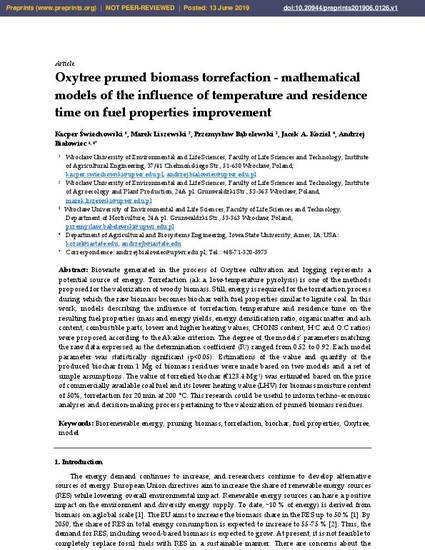
Biowaste generated in the process of Oxytree cultivation and logging represents a potential source of energy. Torrefaction (a.k.a. low-temperature pyrolysis) is one of the methods proposed for the valorization of woody biomass. Still, energy is required for the torrefaction process during which the raw biomass becomes torrefied biomass with fuel properties similar to those of lignite coal. In this work, models describing the influence of torrefaction temperature and residence time on the resulting fuel properties (mass and energy yields, energy densification ratio, organic matter and ash content, combustible parts, lower and higher heating values, CHONS content, H:C and O:C ratios) were proposed according to the Akaike criterion. The degree of the models’ parameters matching the raw data expressed as the determination coefficient (R2) ranged from 0.52 to 0.92. Each model parameter was statistically significant (p < 0.05). Estimations of the value and quantity of the produced torrefied biomass from 1 Mg of biomass residues were made based on two models and a set of simple assumptions. The value of torrefied biomass (€123.4·Mg−1) was estimated based on the price of commercially available coal fuel and its lower heating value (LHV) for biomass moisture content of 50%, torrefaction for 20 min at 200 °C. This research could be useful to inform techno-economic analyses and decision-making process pertaining to the valorization of pruned biomass residues.
Available at: http://works.bepress.com/jacek_koziel/258/

This article is published as Świechowski, Kacper, Marek Liszewski, Przemysław Bąbelewski, Jacek A. Koziel, and Andrzej Białowiec. "Oxytree Pruned Biomass Torrefaction: Mathematical Models of the Influence of Temperature and Residence Time on Fuel Properties Improvement." Materials 12, no. 14 (2019): 2228. DOI: 10.3390/ma12142228. Posted with permission.